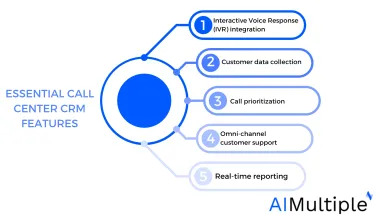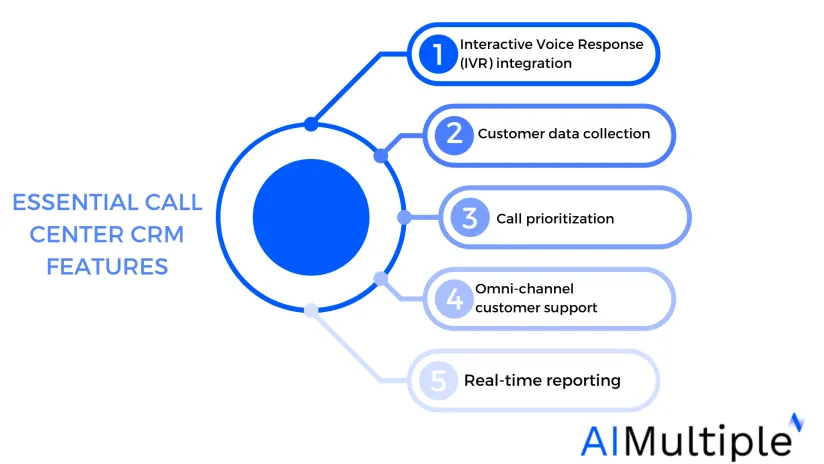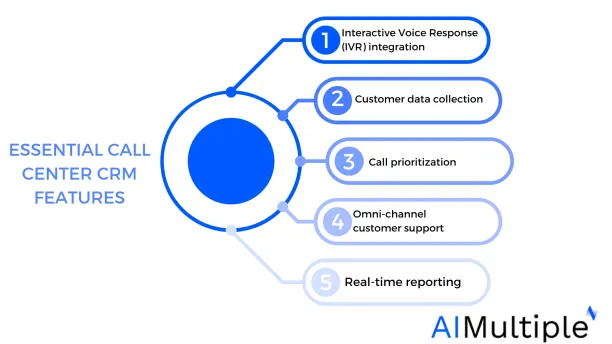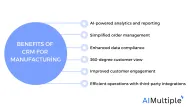An In-Depth Guide to Call Center CRM in 2024


As customer satisfaction can make or break a business, companies are under increasing pressure to deliver top-notch services. Research shows that 60% of customers now have higher expectations for service, yet 68% of companies feel they’re falling short, particularly when it comes to handling customer inquiries.1 This is where call centers, often the first point of contact for customers, play a crucial role.
By integrating Customer Relationship Management (CRM) and contact center systems, call centers can operate more efficiently and provide better service. However, given the abundance of solutions in the market and their conflicting messages, call center operators are confused about important features and how to choose the right solution.
In this article, we’ll explore the CRM benefits of call centers for both customers and call center representatives, its best practices, and the essential features to look for in a call center CRM software.
What is CRM call center software?
Call center CRM systems are specialized tools designed for call centers to manage and analyze customer interactions and data. They aid in enhancing the efficiency and effectiveness of a call center’s operations. The primary goal of a call center CRM is to:
- Improve the relationship with existing customers
- Find new potential customers
- Win back former customers
- Increase collaboration among the employees.
For those interested, here is our comprehensive vendor guide on CRM software.
What is the difference between a call center and a contact center?
Contact centers manage multiple communication channels, such as email, live chat, social media, or video conferences. Call centers, on the other hand, are specifically designed to handle inbound (e.g., customer service) or outbound (e.g., telemarketing) calls.
4 benefits of CRM for a call center
1- Process automation
Figure 1. Percentage of companies not implementing automation effectively in their operations.
Process automation in customer service is about using technology to handle repetitive tasks automatically. Despite its benefits, over 80% of companies don’t have an established automation system for customer service issues.2 This can lead to inefficiencies and errors, and put extra pressure on call center agents.
By using a CRM, companies can automate call center operations like logging calls and updating customer information. This not only streamlines operations and reduces errors but also allows agents to focus on more important tasks like solving customer problems. In short, process automation in a call center CRM can improve efficiency, customer service, and agent productivity.
2- Single source for customer data
More than 70% of business executives say they lack a comprehensive view of customer interactions.3 A CRM system centralizes customer data, providing a single source of information. This means employees can see a customer’s past interactions, queries, and other details in a structured way. This helps agents understand the customer’s needs and provide more personalized service.
3- Effective collaboration among employees
Figure 2. Percentage of companies having trouble in getting the right teams to collaborate.
Research shows that more than 70% of businesses struggle to bring together the proper teams (See Figure 2). CRM systems facilitate collaboration among employees. They allow employees to share information, coordinate tasks, and work together to solve customer issues. This leads to faster resolution times and a more consistent customer experience.
4- Access call records for training purposes
Figure 3. Companies not satisfied with the quality of training materials for their employees.
A survey of business executives found that 80% are not satisfied with their training programs/materials (see Figure 3). CRM systems can record calls, which can be used for training purposes. This helps new employees learn from real-life interactions and improves the overall quality of service.
Analyze customer sentiment from call data
Research reveals that using tools that assist firms in understanding their customers’ feelings and opinions (e.g., sentiment analysis, online behavior tracker, or face/voice recognition) significantly contributes towards corporate revenue growth.
Analyzing customer sentiment from call data in a CRM involves recording phone calls, transcribing them into text, and using sentiment analysis tools to assess the emotions and attitudes expressed by customers. This data is then linked to the customer’s profile in the CRM.
By doing this, call center agents can tailor their approach to each customer based on their sentiment, and managers can identify trends in customer sentiment. This helps companies understand how customers feel about their products or services and allows them to improve their customer service.
> Essential features of call center CRM software

1- Interactive Voice Response (IVR) integration
IVR system is an AI technology for call and contact centers that allows customers to interact with a company’s phone system via voice or touch-tone keypad. It can route calls to the most appropriate agent or department, provide answers to frequently asked questions, or offer self-service options, enhancing the overall customer experience. This automatic call distribution reduces operational difficulties and saves time for both customers and employees.
2- Customer data collection
A call center CRM’s ability to gather and centralize customer data is paramount. This feature allows employees to access a customer’s entire interaction history, from previous call recordings to purchase history and feedback. With this comprehensive view, agents can provide more personalized service, anticipate customer needs, and resolve issues faster. By having all the information at their fingertips, agents can reduce the need for customers to repeat information, leading to a smoother and more efficient customer experience.
3- Call prioritization
Call prioritization is a feature that allows call centers to rank incoming calls based on predefined criteria, such as the urgency of the issue or the skills required to handle the call. This ensures that high-priority calls are answered first, improving customer satisfaction and maximizing the efficiency of the call center. For instance, a call from a high-value customer with a critical issue can be routed to a senior agent immediately, while a general inquiry can wait in the queue.
4- Omni-channel customer support
CRMs Omni-channel customer support is a call center solution that enables interaction with customers across multiple channels, including phone, email, chat, and social media, all from a single platform. This provides a seamless and consistent customer experience, regardless of the channel used. For example, a customer who starts a conversation via chat can switch to a phone call without having to repeat their issue, as the agent will have access to the entire interaction history. By doing this, call centers can expand their functionality.
To discover the use cases of omni-channel customer support on software products, please read our intriguing article on social customer service software.
5- Real-time reporting
Call center tools offer real-time reporting possibilities to help managers have up-to-the-minute data on key performance indicators, such as:
- Call volume
- Average handle time
- First-call resolution
- Agent performance.
This feature allows managers to make informed decisions, identify trends, and address issues as they arise. For instance, if a sudden spike in call volume occurs, managers can quickly allocate additional resources to handle the increased demand and prevent long wait times for customers.
For those interested, here is our data-driven list of CRM software.
If you need guidance in the vendor selection process, we would like to help:
External Links

Cem has been the principal analyst at AIMultiple since 2017. AIMultiple informs hundreds of thousands of businesses (as per similarWeb) including 60% of Fortune 500 every month.
Cem's work has been cited by leading global publications including Business Insider, Forbes, Washington Post, global firms like Deloitte, HPE, NGOs like World Economic Forum and supranational organizations like European Commission. You can see more reputable companies and media that referenced AIMultiple.
Throughout his career, Cem served as a tech consultant, tech buyer and tech entrepreneur. He advised businesses on their enterprise software, automation, cloud, AI / ML and other technology related decisions at McKinsey & Company and Altman Solon for more than a decade. He also published a McKinsey report on digitalization.
He led technology strategy and procurement of a telco while reporting to the CEO. He has also led commercial growth of deep tech company Hypatos that reached a 7 digit annual recurring revenue and a 9 digit valuation from 0 within 2 years. Cem's work in Hypatos was covered by leading technology publications like TechCrunch and Business Insider.
Cem regularly speaks at international technology conferences. He graduated from Bogazici University as a computer engineer and holds an MBA from Columbia Business School.
To stay up-to-date on B2B tech & accelerate your enterprise:
Follow on

Comments
Your email address will not be published. All fields are required.